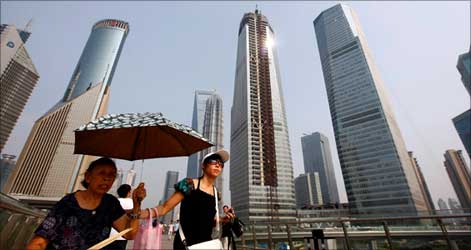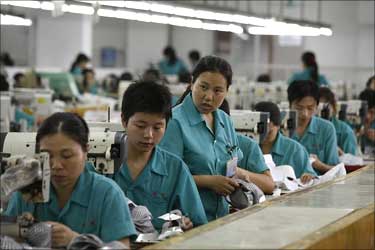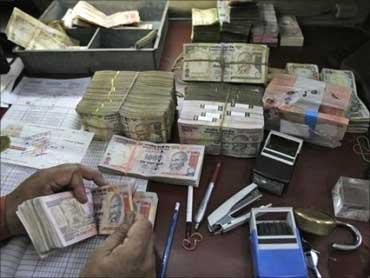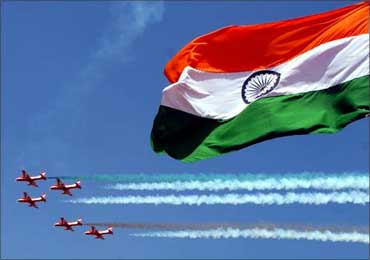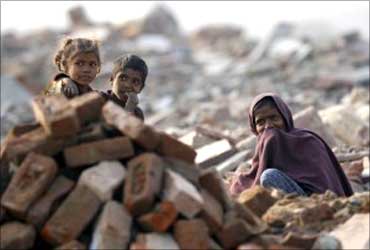 | « Back to article | Print this article |
India to outpace China by 2013-15! Here's why
A Morgan Stanley report -- India and China: New Tigers of Asia -- jointly written by Chetan Ahya and Tanvee Gupta says that India would match China's GDP growth of around 8.5-9.5 per cent over the next two years, barring another global financial crisis, reaping the rewards of very positive demographics and an increasingly dynamic economy.
More importantly, the report adds that by 2013-15, India will start outpacing China's GDP growth.
Morgan Stanley's chief economist for China, Qing Wang, believes that China's growth will move towards a more sustainable rate of 8 per cent by 2015, following the remarkable 10 per cent average over the past 30 years.
By 2020, the report forecasts that India's GDP will cross the $6 trillion mark, while China's will surpass $20 trillion, driven by the powerful combination of favourable demographics, structural reforms, and globalisation.
The two Asian economies are seen to be the dominant growth stories for the next 20 years, the report adds.
India to outpace China's growth by 2013-15
The authors of the report believe that India's growth will accelerate to a sustainable 9-10 per cent by 2013-15, after an average of 7.3 per cent over the past 10 years.
In other words, over the next 10 years, India's growth is expected to outpace China's and India's per-capita income to reach China's 2009 levels of $3,750 over the next 10-11 years.
India will see further rise in investments to GDP, particularly infrastructure, and China will see a gradual rise in consumption GDP.
Click on NEXT to read more...
India to outpace China by 2013-15! Here's why
India is transitioning to higher sustainable growth rates
India's GDP growth has moved from a range of 6 per cent in the early 2000s to 8-8.5 per cent currently. This has happened because three key factors, the Morgan Stanley report says.
First, the improvement in demographics as measured by declining age-dependency (the ratio of the dependent population size to the working-age population size) has been the most important factor supporting this acceleration in growth.
The ratio of the number of elderly people and children to the working-age (aged 15-64 years) population has declined from 68.6 per cent in 1995 to 55.6 per cent in 2010, according to United Nations estimates.
This means that the working-age population has grown faster than the dependent population. This has helped support a structural rise in domestic savings.
Second, structural reforms have improved the utilisation of the working-age population, a key resource. A positive demographic trend may be a necessary condition for strong growth, but it is not sufficient alone.
Favourable demographics need to be converted into a virtuous cycle of acceleration in growth. A critical step in this process is the opening up of productive job opportunities through reforms.
Over the years, India's government has been initiating reforms to encourage private sector investment, which helps create the platform of employment for the working-age population, the Morgan Stanley report says.
In this context, one of the long-standing challenges for India was acceleration in infrastructure spending. The government has finally been able to address this, at least to some extent.
Click on NEXT to read more...
India to outpace China by 2013-15! Here's why
The authors expect infrastructure spending to rise to 8 per cent of GDP in 2010 from 7.5 per cent of GDP in 2009 and 5.4 per cent of GDP in 2005.
Similarly, business capital expenditure has been accelerating, except for during the recent period following the global credit crisis.
The corporate sector has evolved from infancy to be ready to grow in an open global competitive environment. This rise in investment has indeed created the employment platform for the growing working age population. These reforms have played a critical role in boosting productivity growth.
Third, globalisation, as reflected in the steady rise in exports-to-GDP and capital inflows-to-GDP has also helped accelerate the pace of growth. India has relied on both goods and service exports. India's performance in services has been a key differentiating factor.
The authors of the report believe that services exports have higher value-added components and more potential in terms of the impact on the rise in savings rate.
India's share in global services exports increased to 2.6 per cent in 2009 from 1.1 per cent in 2000. India has benefited significantly from a rise in capital inflows, the report adds.
Click on NEXT to read more...
India to outpace China by 2013-15! Here's why
Why India lagged China in performance
China has managed to convert its advantage of a growing working population into a virtuous loop of creating productive jobs for its expanding workforce and translate this to higher savings, investment, and growth since the early 1980s, says the report.
China's age dependency peaked in 1965 at 80.4 per cent. Since then, the country's working population has been rising sharply.
Its age dependency fell to 67.4 per cent in 1980, 48.2 per cent in 2000, and 39.1 per cent in 2010. Concurrently, China's government has been able to increase productive employment opportunities and, in turn, generate higher savings.
China's savings rate increased from about 25 per cent in the mid-1960s to 35 per cent in 1980, 37.5 per cent in 1990, and 51.4 per cent in 2009, supporting a major rise in investments to GDP.
Real GDP growth in China has averaged 10 per cent annually over the past 30 years, compared with 6.2 per cent in India. During this period, China's GDP grew 16 times to $5 trillion, whereas India's rose seven times to $1.2 trillion.
China's exports (including services) surged 65 times over this period to $1,330bn while India's exports increased 22 times to $250bn.
The lag in India's performance, the Morgan Stanley report adds, was due to the lower level of support from demographic, reform, and globalisation factors. India's demographic cycle is trailing China's.
Click on NEXT to read more...
India to outpace China by 2013-15! Here's why
Although the two had similar age-dependency ratios in the late 1970s, China has far outpaced India in the past 20 years. China was also well ahead of India in initiating structural reforms, introducing them in the late 1970s versus in the 1990s in India.
"One could argue," the authors say, "that the pressure on policy makers to create jobs emerged earlier in China because of the way the change in the working-age population progressed there. India was also late in deciding to participate in globalisation, as reflected in the import tariff trend."
India's integration with the global economy started to accelerate in the early 1990s while China's integration began in the early 1980s.
For example, India had import tariffs above 30 per cent until the early 1990s. India is following the same path as China when one compares their export-to-GDP ratios, keeping the starting points for both as the years in which the countries initiated the liberalisation that allowed their resources to interact with those of the rest of the world.
However, India's GDP growth is now inching closer to China's. Over the past three years, India has been narrowing the gap with China in terms of GDP growth.
In 2010, India's GDP growth is estimated to be at around 8.5 per cent and China's at 10 per cent.
Click on NEXT to read more...
India to outpace China by 2013-15! Here's why
India to start outpacing China from 2013-15
The demographic trend is likely to diverge in the two countries. China is expected to reach an inflexion point in its age-dependency ratio around 2015.
The UN estimates China's age-dependency ratio will rise from 39.1 per cent in 2010 to 40 per cent in 2015 and 45.8 per cent in 2025, whereas India's will continue to improve from 55.6 per cent in 2010 to 51.7 per cent in 2015 and 47.2 per cent in 2025.
This would be reflected in the median age in China, which by 2020 would reach 37.1 compared with 28.1 for India.
The economic impact of India's demographic trends should improve further as age dependency declines.
India to become largest supplier of workforce
India will account for almost 26 per cent of the increase in global working-age population over the next 10 years, according to UN estimates.
The large surplus in India's working population is forcing recognition in the world economy of the country's role in global competition and output dynamics.
As mentioned, UN data show that, by 2020, India will contribute an additional 136 million people to the global labour pool.
In comparison, China and the United States will contribute 23 million and 11 million, respectively, while Japan's and Europe's working populations are estimated to decline by 8 million and 21 million.
Demographics alone are not sufficient for acceleration in GDP growth and it is important that the working population is educated. Over the past few years, the trend in education in India has improved significantly.
The quality mix of the fresh additions to the workforce over the next 10 years is likely to change dramatically.
Click on NEXT to read more...
India to outpace China by 2013-15! Here's why
The authors of the report estimate that only 7-9 per cent of India's population moving into the 15-plus age bracket is illiterate and that this could dip well below 5 per cent over the next 2-3 years.
India could emerge as the global leader in producing secondary- and tertiary-educated talent over the next 10 years if supportive policy measures are adopted.
Primary school enrolment rates have risen significantly in India over the past few years -- on a net and gross basis to 90 per cent and 113 per cent, respectively.
If current trends continue, the number of students graduating from primary school each year (out-turn) could increase from 18mn in 2009 to 20.3mn in 2015 and 21.4mn in 2020. The impact of higher enrolment would be felt on out-turn at the secondary and tertiary levels too.
This would imply an increase in India's tertiary-educated workforce size from 50-52 million in 2009 to 114 million by 2020.
Click on NEXT to read more...
India to outpace China by 2013-15! Here's why
By 2020, India will most likely have the largest annual turnout of tertiary graduates globally.
The availability of infrastructure and teachers will be the key to ensuring the quality of education and supply of an educated workforce does not become constrained with the rapid growth.
Over the next 12 to 24 months, the pace of economic reforms is likely to pick up in India with the government initiating the following:
(a) Further steady reduction in subsidies: The government announced a 10 per cent hike in urea (fertilisers) prices and a new nutrient-based subsidy in February 2010. For gas, the government approved a revision of administered gas prices effective June 2010. These measures will effectively reduce subsidy expenditure.
(b) Introduction of Goods and Services Tax: A transition to GST would be an important milestone from a macro perspective, moving from the current system of different types of indirect taxes and multiple rates of indirect taxes. The new system would cover a wider base, including all goods and services.
(c) Direct tax reforms: These reforms aim to broaden the tax base and will minimise exemptions. The Union Budget for 2010-2011 confirmed a plan to implement direct tax reforms as recommended in the Direct Taxes Code from 2012. The new tax code also aims to encourage long-term savings.
Click on NEXT to read more...
India to outpace China by 2013-15! Here's why
(d) Consolidation of the public sector deficit: The government has accepted in principle the recommendation by the 13th Finance Commission for a fiscal roadmap for fiscal deficit and revenue deficit for 2010-15.
The commission's includes the following medium-term fiscal consolidation plan: (i) to cut the consolidated (centre plus state government) fiscal deficit to 7.3 per cent of GDP by F2012 and 5.4 per cent of GDP in F2015. (ii) This will enable the government to reduce consolidated public debt to GDP to 76.6 per cent of GDP by March 2012 and 67.8 per cent of GDP by March 2015.
(e) Meaningful steps towards divestment of the government's stakes in PSUs: The government plans to accelerate the divestment plan and is targetting collection proceeds.
The budget target calls for raising 400 billion ($8.7 billion, 0.6 per cent of GDP) from divestments in 2010-2011 compared with an estimated 250 billion ($5.5 billion, 0.4 per cent of GDP) in 2009-2010.
The value of the government's stakes in listed state-owned enterprises is estimated at $300 billion. If unlisted companies are included, the value would be approximately $450 billion.
(f) Acceleration in infrastructure spending, particularly for roads and power: The Planning Commission has estimated the infrastructure investments in 2013-17 will rise to a cumulative $1 trillion compared with $542 billion in 2007-12.
Key areas where infrastructure spending is rising include power, roads, and telecoms, a plan which the Morgan Stanley report calls 'realistic and achievable'.
(g) FDI in retail marketing and distribution: The government is likely to allow foreign direct investment in multi-brand retail distribution soon, with conditions attached for compulsory contribution to back-end infrastructure investments and absorption of rural work force.
India, at present, allows FDI in single-brand retailing to the extent of 51 per cent, and 100 per cent for cash-and-carry wholesale trading.
If the government were to allow FDI in the retailing sector for multi-brands, it would result in a dramatic increase in retail sector growth.
Click on NEXT to read more...
India to outpace China by 2013-15! Here's why
India to offer best growth opportunity over the next 25 years
Over the next 20-25 years, the Morgan Stanley study expects India to remain the highest growth economy among large countries.
India could have the advantage of maintaining its high-growth phase for a longer period than East Asia did as UN data shows that India's age dependency will continue to decline until 2040.
Indeed, UN projections show that India will be the only large country which will still have favourable demographics after 2010. Japan, Europe, and the US (in that order) will have a significant rise in their ageing populations.
So, while in the past 20 years, China has benefited ahead of India from a faster fall (improvement) in age-dependency ratio, over the next 20-25 years India will have this advantage.
Click on NEXT to read more...
India to outpace China by 2013-15! Here's why
Internal challenges to sustain strong growth story
However, there are several challenges to India's high growth story.
First, the government needs to ensure that it delivers on execution of infrastructure development. The trend in China over the past 25 years indicates that, for 10 per cent sustainable GDP growth, India would need to increase infrastructure spending to 10 per cent of GDP from the current 7.5 per cent.
Second, one of the key pillars of the strong outlook for India is a structural rise in domestic savings and investments. Thus reduction of the government's revenue deficit would be critical.
Third, labour law reform would need to be prioritised. The sustained growth in SMEs (small and medium enterprises) will be an important driver of India's growth.
Fourth, development of less-developed states. Rising income inequality and high poverty levels in some states have increased the probability of social instability.
Already, a few states have faced insurgency from Naxalites and the internal security threat from this movement is a concern.
Fifth, as discussed, significant progress has been made in improving primary and tertiary education. The success of primary education has meant the demand for the secondary education infrastructure is beginning to rise rapidly.
Click on NEXT to read more...
India to outpace China by 2013-15! Here's why
India's economic growth underwent a structural shift at the start of the 1980s. Over the decade, the government took an attitude shift in favour of the private sector.
India's economic growth averaged 5.7 per cent a year in the 1980s versus 3.5 per cent in the prior three decades. Since 1991, India has initiated major liberalisation measures, adopting the open-economy model. India has achieved average growth of 6.6 per cent a year since 1991, and in the past five years, growth has averaged 8.5 per cent.
The emphasis for China remains manufacturing and for India, services.
A simplistic way to account for growth in a country would be to consider the contributions from the three basic drivers: (1) labour force inputs, (2) capital inputs, and (3) Total Factor Productivity (TFP). TFP is that part of non-factor inputs that enables higher growth with less application of factor inputs. It encompasses the contribution of technology and managerial aspects to the growth of real output.
The two major areas where India's growth suffers compared with that of China are capital accumulation and lower productivity growth.
In the past 10 years, on average, about 5.4 percentage points of China's GDP growth was accounted for by capital accumulation, supported by a high national savings rate.
Click on NEXT to read more...
India to outpace China by 2013-15! Here's why
In comparison, capital accumulation in India contributed only about 3.4 percentage points of GDP growth. For India, the proportion of its growth accounted for by TFP was lower than that for China on average in the past 10 years.
Although in nominal US dollar terms, India's GDP is 26 per cent of China's size, India's consumption spending is about 38 per cent of China's. India's overall consumption-to-GDP ratio was 70 per cent in 2009 compared with 49 per cent for China.
Over the years, as the age-dependency ratio has declined, the two countries' consumption-to-GDP ratios have also decline.
Even so, India's consumption-to-GDP ratio is slightly higher than China's relative to the demographic position. India's active consumerism culture, populist attitude of the government, and larger share of household income in GDP are key reasons for consumption's relatively higher share of GDP.
Over the next few years, as China's age-dependency starts to rise, it will see a gradual rise in consumption to GDP, whereas in India, as its age-dependency ratio continues to decline, we expect a further reduction in consumption to GDP.
However, whether India manages to live up to the huge potential that the optimistic Morgan Stanley report outlines is debatable and solely depends on the government's policy thrust and intentions.



